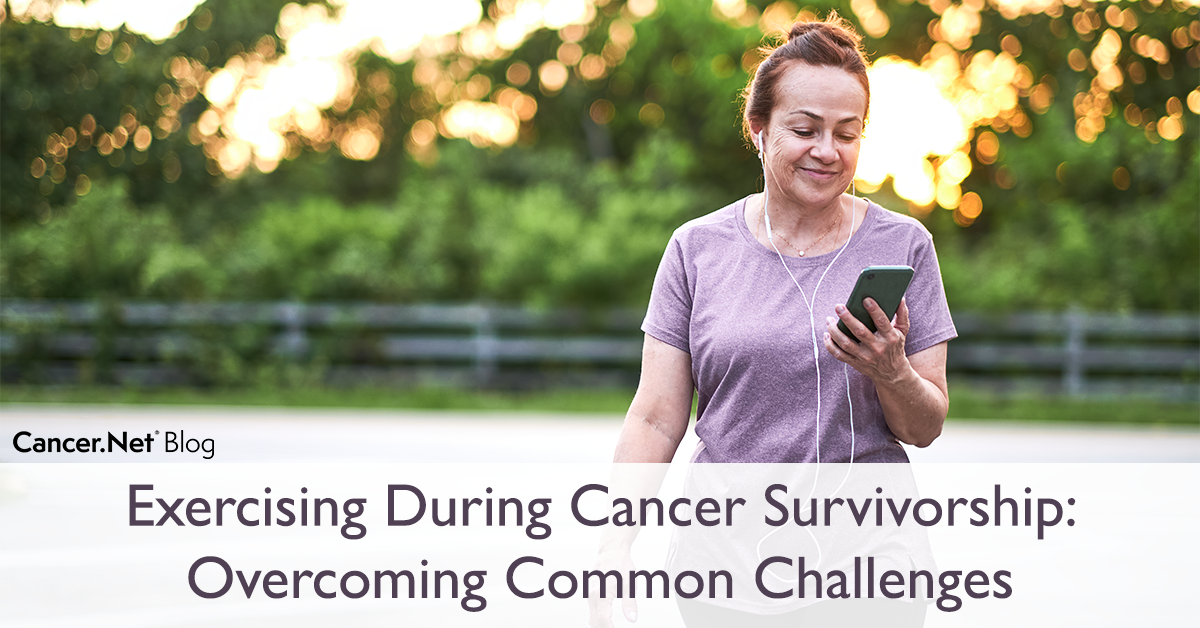
Sharon Leslie, PT, DPT, is a physical therapist specializing in cancer rehabilitation and survivorship. She founded the cancer rehabilitation program at the Palo Alto Medical Foundation and is an Advisory Panelist on the Cancer.Net Editorial Board. Sharon is also the founder of VaxVolunteers.org, a centralized hub for volunteer opportunities at COVID vaccine sites across the United States. She is currently an MPH candidate at Johns Hopkins Bloomberg School of Public Health, focusing on global and humanitarian health.
Being physically active and exercising regularly is important for the health and quality of life of all people, but especially for cancer survivors. If you are a survivor, you may have heard the advice to return to “normal” activity after cancer treatment. However, cancer survivors may face some unique challenges when it comes to physical activity that can often be confusing as they begin to think about incorporating exercise into their daily lives.
Here, learn why exercise is vitally important to cancer survivors, what some of the challenges you may face are, and how you can safely overcome those challenges. Everyone’s needs are different, especially during and after cancer treatment, so be sure to talk with your doctor about what type and duration of exercise they recommend for you.
Why exercise is important for cancer survivors
Exercise can provide all kinds of benefits for cancer survivors. Regular exercise can increase energy and quality of life, decrease side effects of treatment, reduce fatigue, improve muscle strength and bone health, and reduce the risk of new cancers in the future. Exercise also gives people a way to regain control over their bodies after going through treatment and can even help their brain work better.
Common challenges of exercise for cancer survivors
If you are finding it hard to include exercise in your life after cancer treatment, you are not alone. Many cancer survivors experience roadblocks and challenges that get in the way of starting or continuing a regular exercise program. Some of the most common challenges cancer survivors face when it comes to physical activity are described below, along with tips to help.
Fatigue
Fatigue is one of the most common and problematic symptoms among people with cancer and survivors. Cancer-related fatigue isn’t relieved by sleep and can often be debilitating for people. For a person who is going through or who has completed cancer treatment, it may seem counter-intuitive to think that exercise is going to make them feel less fatigued or tired. But, in fact, it does. Exercise is particularly effective in treating fatigue in people with a history of cancer.
The best idea is to start small and set yourself up for success. Too tired to go to the gym? Take a walk around the block instead. You may find that you are less fatigued after exercise if you exercise in moderation. Short bouts of exercise are better than long ones when fatigue is an issue for you, so prioritize your activity depending on your needs of the day.
Lymphedema
Cancer survivors may be scared that exercise will cause lymphedema, a buildup of fluid in the body’s soft tissue due to a blockage in the lymphatic system. In fact, the medical community used to warn patients against exercise for this reason. Thankfully, we now know that this is not true. Research shows that a strong, healthy body is the best defense against lymphedema. When done correctly, exercise can be an integral part of your life if you are also dealing with lymphedema.
People with existing lymphedema can start by wearing a compression sleeve while exercising. The key is to start low and start slow. Use low weights for strength training and gradually work your way up. People with lymphedema will benefit from shorter, more frequent bouts of exercise rather than longer sessions. As always, talk with your doctor or physical therapist to ensure your lymphedema is under control before embarking on a new exercise program.
Neuropathy
Many people diagnosed with cancer who have received certain types of chemotherapy will develop chemotherapy-induced peripheral neuropathy (CIPN). Peripheral neuropathy is a nerve problem that can cause numbness and tingling in your hands and feet and affect your balance and strength. Survivors with diabetes, in particular, may be at greater risk for developing CIPN.
Exercise can have a major impact on the symptoms of CIPN by increasing balance, decreasing fall risk, preventing muscle loss, and increasing endurance. Remember to wear supportive, well-fitting shoes in and out of the gym to help with balance. If you have numbness in your hands, it might be hard to hold weights. However, there are many other options available at the gym to modify weightlifting, like using weights with Velcro or using therapy bands.
How to get started with exercise during survivorship
Starting an exercise program during survivorship can seem daunting. It is important to start small and not worry about what you used to be able to do before cancer. Create a new baseline and make realistic goals for yourself. Find something you love to do. For example, if you love yoga, find a great class. If you love walking, do that! You are more likely to stick with something that you love and that you can easily incorporate into your life.
You can also find an exercise partner. Working out with others gives you a sense of accountability and community. Ideally, you can work up to 2 to 3 resistance exercise sessions per week, such as weight training, squats, lunges, or free weights, and at least 150 minutes of moderate intensity aerobic exercise, such as walking, jogging, dancing, or swimming.
If you have pain or other issues, like a decreased range of motion, find a cancer rehabilitation specialist who understands the ins and outs of cancer survivorship. They can help identify what special issues you may have that are getting in the way of exercising independently.
Whether you loved exercising before cancer or were more of a spectator, you can make a big difference in your physical and emotional well-being by adding exercise into your weekly routine. Find something you love to do (or even like to do!), set achievable goals, and soon you will begin to see the benefits of incorporating physical activity into your life.
The author has no relevant relationships to disclose.
Read more exercise content on the Cancer.Net Blog.





